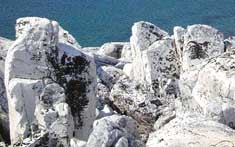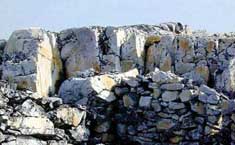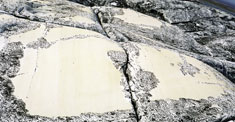 |
||||
Hudson Bay • Nunavut • Canada | ||||
Startling GeologyThis island is all of a white marble. - British explorer Luke Foxe, 1631
Of course it is not really marble, but massive veins of quartzite that give the four islands of Marble Island their startling appearance. Like so much about Marble Island, the rocks themselves can tell different stories depending on weather, time of day and how closely you look... Beyond the superficial constancy of the rock was surprising diversity. Even the colour changed. Mostly the quartzite was the sterile white of a hospital room, but at other times, faint pink or splashed with tawny stains. Just once there was the brilliant green of malachite. There was an eeriness to the landscape... once, when a full moon lifted above the rim of the earth and cast its pale light, the stone took on the ghostly burnish of white marble. - Beattie & Geiger, Dead Silence, 1993. According to a Marble Island Log Book now out of print, "Deadman's Island is made of dark green stripes of sedimentary rock called whacky. All the rest of the islands are made of a type of sandstone that has a tendency to erode into a fine white powdery sand. All islands are laced with veins of quartzite veins, which are difficult to see since the host rock is similar colour. Every once in a while pale green spots of verigrise will be encountered. They look as if spray pointed onto the rock surface. The north shore of the main island also has a very striking 300-metre band of stripped grey wacky, running east to west for about 2 miles." Marble Island has been emerging from Hudson Bay at the rate of approximately a metre a century for ten thousand years -- since this part of the earth's surface began to rebound after the last great Ice Age. A visitor in 1889 reported, "The stratification (of the quartz) is usually very massive. Ripple marks, varying from coarse and wide to fine and narrow, were observed on the surfaces of many of the beds, especially the thinner ones. Near the southwestern point of the island, the quartz presents beautiful lilac colours of various shades. Here the directions of the dip is N 57° E, true ( the magnetic variance being 5°W), and the inclination 80° from the horizontal plane... The strike of the bedding varies considerably in different places..." What plants and animals can inhabit such a rocky place? On to the wildlife page. |
|
|||
| | ||||


